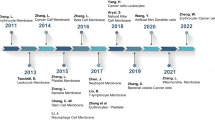Abstract
The targeted delivery of pharmacologically active molecules into the cytosol of mammalian cells is a central goal of experimental pharmacology and pharmacotherapy. By coupling cell-permeable bacterial protein toxins to streptavidin, we generated modular hybrid protein carriers for specific delivery of biotin-labelled molecules into the cytosol of target cells.
Similar content being viewed by others
Literatur
Barth H, Stiles BG (2008) Binary actin-ADP-ribosylating toxins and their use as molecular Trojan Horses for drug delivery into eukaryotic cells. Curr Med Chem 15:459–469
Fahrer J, Plunien R, Binder U et al. (2010) Genetically engineered Clostridium botulinum C2 toxin as a carrier system to deliver biomolecules into mammalian cells. Bioconjugate Chem 21:130–139
Fahrer J, Schweitzer B, Fiedler K et al. (2013) C2-streptavidin mediates the delivery of biotin-conjugated tumor suppressor protein p53 into tumor cells. Bioconjugate Chem 24:595–603
Christow H, Lillich M, Sold A et al. (2013) Recombinant streptavidin-C3bot for delivery of proteins into macrophages. Toxicon 75:144–147
Fahrer J, Rausch J, Barth H (2013) A cell-permeable fusion protein based on Clostridium botulinum C2 toxin for delivery of p53 tumorsuppressor into cancer cells. PLoS One 8:e72455
Fahrer J, Kuban J, Heine K et al. (2010) Selective and specific internalization of clostridial C3 ADP-ribosyltransferases into the cytosol of macrophages. Cell Microbiol 12:233–247
Dmochewitz L, Förtsch C, Zwerger C et al. (2013) A recombinant fusion toxin based on enzymatic inactive C3bot1 selectively targets macrophages. PLoS One 8:e54517
Wurm J, Klos HJ, Räder H et al. (2009) Synthesis and noncovalent protein conjugation of linear-hyperbranched PEGpoly( glycerol) alpha,omega(n)-telechelics. J Am Chem Soc 131:7954–7955
Tao L, Geng J, Chen G et al. (2007) Bioconjugation of biotinylated PAMAM dendrons to avidin. Chem Commun 33:3441–3443
Ng D, Fahrer J, Eisele K et al. (2013) Efficient delivery of p53 and cytochrome c by supramolecular assembly of a dendritic multi-domain delivery system. Adv Healthc Mater 2:1620–1629
Albertazzi L, Serresi M, Albanese A et al. (2010) Dendrimer internalization and intracellular trafficking in living cells. Mol Pharm 7:680–688
Kuan S, Ng D, Wu Y et al. (2013) pH responsive Januslike supramolecular fusion proteins for functional protein delivery. J Am Chem Soc 135:17254–17257
Author information
Authors and Affiliations
Corresponding author
Additional information
Holger Barth Jahrgang 1965. 1986–1991 Biologiestudium an der TU Darmstadt. 1992–1994 Dissertation am Deutschen Krebsforschungszentrum (DKFZ), Heidelberg. 1995–2004 Arbeitsgruppenleiter am Institut für Experimentelle und Klinische Pharmakologie und Toxikologie an der Universität Freiburg. 2002 Habilitation. 2005 Fachtoxikologe DGPT. Seit 2004 C3-Professor für Pharmakologie und Toxikologie an der Universität Ulm. 2010 Forschungspreis der der Deutschen Gesellschaft für Toxikologie (GT), seit 2011 stellvertretender Vorsitzender der GT.
Tanja Weil Jahrgang 1973. 1993–1998 Chemiestudium an der TU Braunschweig und der Université de Bordeaux I, Frankreich. 2002 Dissertation am Max-Planck-Institut für Polymerforschung, Mainz. 2002–2008 Gruppenleiterin, Abteilungsleiterin und zuletzt Director of Chemical R&D bei der Firma Merz Pharmaceuticals in Frankfurt a. M. 2008 Associate Professor an der National University of Singapore. Seit 2010 W3-Professorin und Leiterin des Instituts für Organische Chemie III an der Universität Ulm. Seit 2013 Inhaberin eines Synergy Grants des Europäischen Forschungsrats.
Rights and permissions
About this article
Cite this article
Barth, H., Weil, T. Modulare hybride Wirkstoff trans porter auf der Basis bakterieller Toxine. Biospektrum 20, 22–25 (2014). https://doi.org/10.1007/s12268-014-0400-y
Published:
Issue Date:
DOI: https://doi.org/10.1007/s12268-014-0400-y




